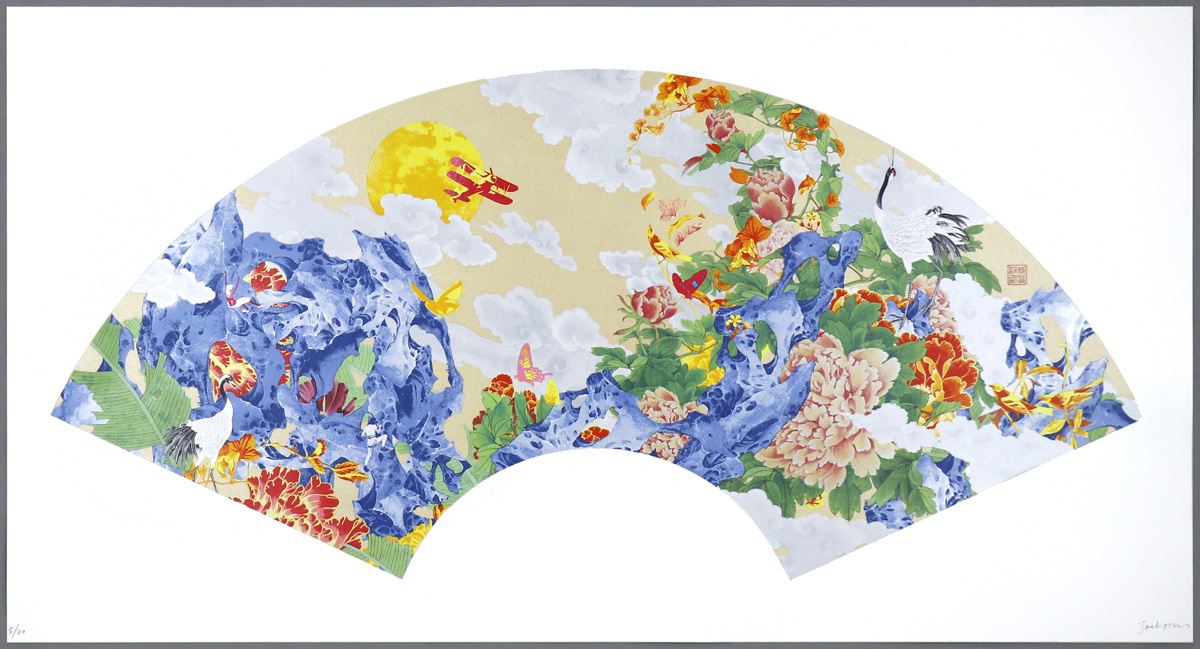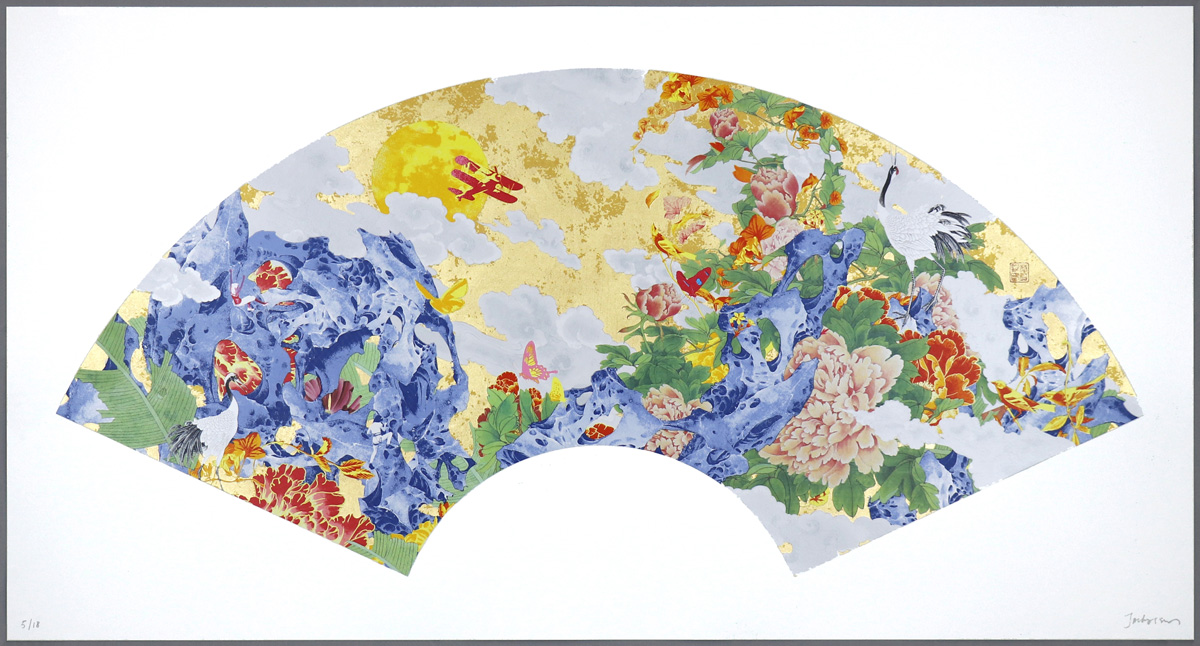As the as sun rises against a warm orange-golden sky,
Jacky Tsai announces a revival. Butterflies, songbirds, cranes, rock climbers and a biplane accompanies the artist’s famous skull, carefully minded by the enlightened Buddha, shaped by small flowers in bloom. For a brief time following the New York solo show, ‘Culture Clash’, Tsai’s focus shifted from bold-coloured energic scenes of Western superheroes and mythological Eastern characters, towards a softer approach as he prepared for his next exhibition titled ‘Reincarnation’. The two print editions,
The Revival and
Golden Revival, were the first step of the artist’s journey.
Narrow, skilfully folded and ten centimetres long, the contracted paper fan in Tang Yin’s hand most of all looked like a squarely formed wooden tool. Once unfolded, however, the black ink on the gold-flecked paper revealed a meticulously drawn illustration next to columns of handwritten hanzi. On the left, stems of bamboo in the midst of a deafening rain-storm - thrown wildly from side to side by the uncontrollable gusts - and on the Eastern part of the fan, a poem that took the reader through the raging storm:
The roar of spring thunder arouses the green bamboo,
Dragon whiskers sweep across the ground, along with long phoenix tails.
Looking up from the boat awning I play the flute,
A bright moon, filling the sky, shines in the Xiao and Xiang Rivers.
‘Bamboo in a Spring Thunderstorm’ by Tang Yin (1470-1524).
Decorated and written by Tang Yin at the height of the Ming Dynasty in the sixteens-century, the folding fan beautifully contrasts the chaos of the storm and the tranquillity that rests upon the river once it has passed. It is an artist’s observation, penned in just three columns of text and a drawing, of being one with nature, the hope and the anticipation of new beginnings.
Tsai, much like Tang, observes the world around him and composes intricate landscapes and storylines to reach a harmony amongst the contradictions. The passing storm over the river banks is just as contemporary in its time - though four hundred years apart - as the cultural “storm” and steady bombardment of impulses experienced by Tsai when he moved to London in 2006 to begin his studies at Central St Martin. Cityscapes and landscapes, commercialism and pop culture became central themes for Tsai in his pursuit to restore balance and reach a peaceful state. In his early works, flowers, butterflies, lush foliage and a squeaking parrot started to form beautiful skulls; and later, an old gramophone, a bicycle and a yellow mechanical fan were blended with Eastern acrobats, vibrant oil-paper parasols and a zebra, magnificently bringing a nostalgic east-west harmony to the heydays of nineteen-thirties’ Shanghai.

JACKY TSAI
The Revival, 2017
Edition of 60
6 Artist Proof (APs)
120(w) x 64(h) cm
47.24(w) x 25.20(h) inches

JACKY TSAI
The Revival, 2017
Edition of 60
6 Artist Proof (APs)
120(w) x 64(h) cm
47.24(w) x 25.20(h) inches
|
|
|
120(w) x 64(h) cm
47.24(w) x 25.20(h) inches
|
18 colour screenprint on Somerset 410 gsm paper
To see larger and more detailed image (1Mb file opens in new window), please click here
Signed and numbered on front.
Edition of 60
|
|
Ten years on and by now an emerging artist raising eyebrows in the art world for his Eastern pop art, much of Tsai’s recognition stayed tangled to the ‘Flower Skull’ originally commissioned by the British fashion designer Alexander McQueen in 2008. Tsai’s idea was revised path - or an artistic reincarnation - aiming to see his works rise beyond the brilliant skull and take him closer to his roots, while still paying tribute to the artist’s iconic motif. Traditional Eastern art and crafts, such as Lacquer carving, imperial-blue porcelain and Su Xiu embroidery were already regulars in the repertoire and his composition for the new work rising from a landscape-setting proclaiming a new beginning, the choice of a classical Eastern folding-fan was ideal.
Referencing the Eastern paper folding-fan, a practical item used to block the sun and an evolving status symbol of the Ming dynasty, Tsai transformed a classical object into something very contemporary, in both style and concept.
The Revival features a scenery made up of pink peonies, birds and delicate green vegetation wrapped around a dusty blue and unobtrusive rockery. As with many of Tsai’s works, the clever compositions includes hidden imagery which is not immediately noticeable at first glance. Concealed in the porous rocky landscape on the Western side is an image of a skull, and to the right - at the top of the image in subtle rose tones made from flowers and leaves - the face of Buddha has been formed, looking towards the centre of the print and fronting the skull. The presence of Buddha and the skull forms the basis of Tsai’s ideas associated with revival; one, a motif primarily in the West representing mortality, and Buddha - a symbol of the East - embodying the transition to the next life.
Reiterated through many of the small elements of the work,
The Revival continues the dialogue between two cultures. The biplane against the golden rising sun; rock-climbers trying to conquer the skull; a trumpeting crane announcing a revival; and the style of pearlescent clouds and flowers very reminiscent of those seen in Eastern art. It is a visual skill that Tsai masters and is truly admired for.

JACKY TSAI
Golden Revival, 2017
Edition of 18
4 Artist Proof (APs)
120(w) x 64(h) cm
47.24(w) x 25.20(h) inches

JACKY TSAI
Golden Revival, 2017
Edition of 18
4 Artist Proof (APs)
120(w) x 64(h) cm
47.24(w) x 25.20(h) inches
|
|
|
120(w) x 64(h) cm
47.24(w) x 25.20(h) inches
|
18 colour screenprint with hand-applied 24 carat gold leaf on Somerset 410 gsm paper
To see larger and more detailed image (1Mb file opens in new window), please click here
Signed and numbered on front.
Edition of 18
|
|
The symbolism in
The Revival goes beyond the visual appearance. The manually screenprinted edition of 60 have 18 layers of ink, touching on the lucky number 8, which is pronounced ‘ba’ and similar to that of ‘creating wealth’ in the Mandarin language. In the second edition,
Golden Revival, which is sharing the same composition, Tsai strengthens the associations to good fortune. There are only 18 prints in the edition and on each one of them the sky has been illuminated with hand-applied 24-carat gold leaf; to Tsai a statement to the rich Eastern culture. The two print editions are signed and numbered on front, and were released simultaneously in an exclusive collaboration between
Jacky Tsai and Eyestorm.
More details about the two print editions - and other available works by
Jacky Tsai - can be found on his artist page
here.